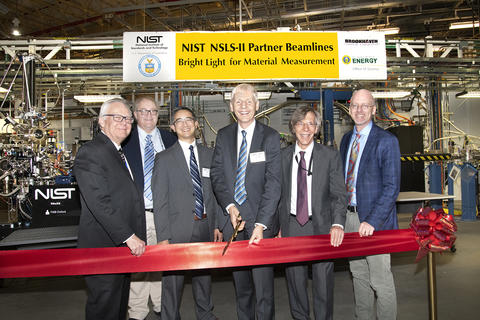
Doon Gibbs (Director, BNL), Jim Misewich (Associate Laboratory Director, Energy and Photon Sciences, BNL) Eric Lin (Director, Material Measurement Lab, NIST), Jim Olthoff (Associate Director for Laboratory Programs, NIST), Dan Fischer (Group Leader, Synchrotron Science Group, NIST), John Hill (Director, National Synchrotron Light Source II, BNL).
On Nov. 6, 2019, NIST celebrated the opening of three new X-ray beamlines at the National Synchrotron Light Source II (NSLS-II) at Brookhaven National Laboratory (BNL), a Department of Energy (DOE) facility in Upton, New York. NIST’s suite of beamlines can be used to measure the electronic, chemical and structural properties of almost any material, often at the nanoscale, providing a route to answering key challenges in microelectronics, biology, energy and nanotechnology.
X-rays are a potent tool for measuring the composition and internal structure of materials. The more powerful the X-ray beam, the more types of materials you can examine, and the NSLS-II is designed to provide extremely bright X-rays. NIST’s new beamlines guide X-rays at three different energy levels, known as “hard” (4.5 keV to 23.6 keV), “tender” (about 2.0 keV to 7.5 keV) and “soft” (0.1 keV to 2.2 keV), for X-ray diffraction and three types of spectroscopy.
X-rays can reveal the relative location and amount of the elements within a given material because each element absorbs light at telltale energy levels. This level of structural detail has been used in the past to develop stronger glass for windshields and mobile electronic devices, for determining the electronic reactions that drive high performance batteries, and to study the structure of cancer-fighting therapeutics.
“With NIST staff stationed at BNL and working closely with our BNL and Department of Energy partners, NIST is strategically positioned to develop measurement and standards needs in these and other areas for decades to come,” said Ron Jones, an engineer with the Material Measurement Laboratory at NIST.
For example, NIST has already begun industry-focused partnerships to apply the new beamlines’ capabilities to enable automotive companies to develop more efficient catalytic converters and batteries. Aerospace companies are preparing to use the beamlines to develop high performance jet engine and rocket components. The microelectronics community plans to use these measurement platforms to develop materials for quantum computing, high density data storage and efficient data transmission.
Consumer product and chemical manufacturers will work with NIST and BNL to better understand how floppy, spaghetti-like polymer molecules pack inside plastics, providing a new opportunity to create stronger, more recyclable plastics.
NIST has worked in partnership with Brookhaven National Laboratory for almost 40 years, and currently its Synchrotron Science Group includes seven people stationed there. The new beamlines will support the emerging materials research priorities of both institutions.
“I’m looking forward to the future, and excited to see how these three new beamlines will make great contributions to everything from quantum to chemistry,” said Jim Olthoff, NIST’s associate director for laboratory programs.

